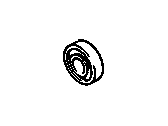
My Garage
My Account
Cart
Genuine Chevrolet Metro Pilot Bearing
Clutch Pilot Bearing- Select Vehicle by Model
- Select Vehicle by VIN
Select Vehicle by Model
orMake
Model
Year
Select Vehicle by VIN
For the most accurate results, select vehicle by your VIN (Vehicle Identification Number).
1 Pilot Bearing found
Chevrolet Metro Pilot Bearing
Each OEM Chevrolet Metro Pilot Bearing we offer is competitively priced and comes with the assurance of the manufacturer's warranty for the part. Furthermore, we guarantee the speedy delivery of your orders right to your doorstep. Our hassle-free return policy is also in place for your peace of mind.
Chevrolet Metro Pilot Bearing Parts Questions & Experts Answers
- Q: How to inspect and replace the clutch pilot bearing on Chevrolet Metro?A:The clutch pilot bearing is a needle roller type bearing fitted to the rear of the crankshaft, pre-greased and sealed for life, mainly to support the front of the transaxle input shaft. Because of this location it should be examined every time the clutch components are pulled and if there is any doubt as to its condition it should be replaced. The first step one is to take off the transaxle, although if the engine has been pulled out this will not be necessary. After that, pull out the clutch parts and examine its pilot bearing for such conditions as scoring or wear, or lack of grease, or dryness or apparent damage to the clutch, with the help of a torch in case the area is dark. This should be replaced if the pilot bearing is badly worn or chafed in any way. While it is advised that a special puller is used, it is also possible to use a '3/4' steel bar; a wood dowel or a socket and a fixed bolt. The bar should fit the bearing very tightly with almost no space in between and after the bar is placed in the bearing, fill up the bearing and the place behind the bearing with thick grease to all air out. Place the bar into the bearing bore and hit it with a hammer in an effort to expel the grease to the back of the bearing thus being pushed out. Bearing removed, clear any traces of grease from the underside of the crankshaft lip recess. For the new bearing put lithium-based grease on the outer side of the bearing and with using soft-face hammer fitted it into the recess in such a way that the seal is outer. Last but not least, replace the clutch components, transaxle and every single part that was unbolted, ensuring that all bolts and nuts are tightened to factory recommended specification.






